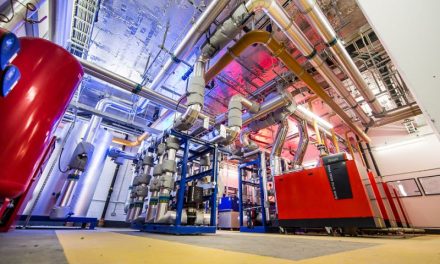 As part of its sustainability strategy (The S Plan), BRE has now completed the commissioning of a new roof mounted photovoltaic (PV) solar array at its large research and office complex in Garston near Watford.
As part of its sustainability strategy (The S Plan), BRE has now completed the commissioning of a new roof mounted photovoltaic (PV) solar array at its large research and office complex in Garston near Watford.
Designed and installed by MCS accredited PV firm South Facing, the new system has been installed to help reduce BRE’s carbon footprint. BRE’s S Plan sets out a four year programme of continuous improvement across eight key areas of sustainability – carbon dioxide emissions, resource efficiency, supply chain engagement, transport, community engagement, ecology, water, and information systems.
The specification of the project was finalised by design engineers at South Facing in close consultation with industry experts at BRE including the organisation’s wind loading and structural engineering specialists as well as BRE Ventures Innovation director, Andrew Williams, and Steve Pester, a leading authority in photovoltaic technologies in the UK.
“We selected a roof on one of our main office buildings for the new PV array and naturally we set our own stringent standards for the installation,” explained Williams. “However, the roof construction provided quite a few challenges in terms of structural loading. We were keen to understand the practical issues that need to be addressed throughout any installation process in order to satisfy both PV system performance requirements as well as all relevant structural and wind loading considerations for the building type and construction method. We also required third party approval of any component used in the installation which meant that manufacturers’ claims and product specifications could not be taken at face value.”
The final installation consists of 128, 230W modules manufactured by Norwegian PV specialist REC and supplied by Chiswick-based Alternergy. These were chosen because of the company’s long product warranty, the performance in European performance trials and the very low embodied carbon associated with the manufacture of the modules. Two SMA Tripower 15,000 three phase inverters, also supplied by Alternergy, supply power to BRE’s electrical distribution network on the ground floor of the building. The system is expected to generate in excess of 23,500kWh per annum.
Significantly, and to provide a long term research/educational tool, the installation also includes a monitoring system with all relevant system data fed to a desktop display as well as to a real time display in the BRE main reception and an online web portal. This uses sensors and dataloggers to monitor wind speed, air temperature, module temperature and solar radiance data so that useful research data is generated and optimal performance can be maintained throughout the system’s lifetime.
The chosen building had a roof constructed from a cast in-situ reinforced concrete T-section slab with rectangular hollow clay block void formers. This was covered in an asphalt membrane with a heavily granulated surface. “This posed quite a few issues,” added South Facing’s Clive Collison. “Because of this, it was clear that the installation would require some special ballasting which would not compromise the integrity of the roof membrane and which would not deliver a point or cumulative load to detract from the structural integrity of any area of the building roof.”
“Because of the roof design, we opted for concrete slabs mounted on expanded foam in order to satisfy all structural considerations and to meet BRE’s requirements for frost resistance and a 30+ year lifecycle. Using 15° aluminium triangles and mounting rails manufactured by REDtip here in the UK, we designed the mounting frame to provide 15 rows of eight modules, with a further two rows of just four modules to eliminate any risk of potential wind uplift (against maximum permissible ballast loading) at the exposed southern end of the building.”
Following the successful completion of the roof-mounted PV system, South Facing is now installing a further ground mounted installation near the entrance to the visitor reception area at BRE as part of BRE’s development work on novel electrical networks.
“We now have a system that not only reduces carbon emissions and generates income but the installation has provided a clear demonstration of some of the practical challenges facing accredited PV installers,” explained Williams. “As a result, the BRE Trust has agreed to fund a case study which will consider the lessons learnt from the installation and their implications on UK building stock.”



